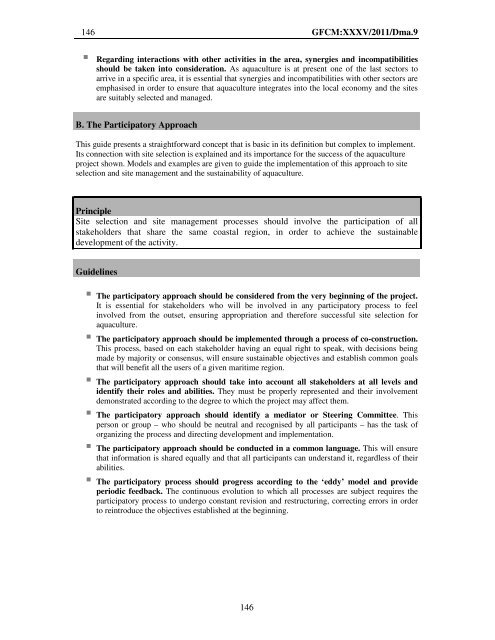Site selection and carrying capacity in Mediterranean ... - FAO Sipam
Site selection and carrying capacity in Mediterranean ... - FAO Sipam
Site selection and carrying capacity in Mediterranean ... - FAO Sipam
You also want an ePaper? Increase the reach of your titles
YUMPU automatically turns print PDFs into web optimized ePapers that Google loves.
146 GFCM:XXXV/2011/Dma.9<br />
Regard<strong>in</strong>g <strong>in</strong>teractions with other activities <strong>in</strong> the area, synergies <strong>and</strong> <strong>in</strong>compatibilities<br />
should be taken <strong>in</strong>to consideration. As aquaculture is at present one of the last sectors to<br />
arrive <strong>in</strong> a specific area, it is essential that synergies <strong>and</strong> <strong>in</strong>compatibilities with other sectors are<br />
emphasised <strong>in</strong> order to ensure that aquaculture <strong>in</strong>tegrates <strong>in</strong>to the local economy <strong>and</strong> the sites<br />
are suitably selected <strong>and</strong> managed.<br />
B. The Participatory Approach<br />
This guide presents a straightforward concept that is basic <strong>in</strong> its def<strong>in</strong>ition but complex to implement.<br />
Its connection with site <strong>selection</strong> is expla<strong>in</strong>ed <strong>and</strong> its importance for the success of the aquaculture<br />
project shown. Models <strong>and</strong> examples are given to guide the implementation of this approach to site<br />
<strong>selection</strong> <strong>and</strong> site management <strong>and</strong> the susta<strong>in</strong>ability of aquaculture.<br />
Pr<strong>in</strong>ciple<br />
<strong>Site</strong> <strong>selection</strong> <strong>and</strong> site management processes should <strong>in</strong>volve the participation of all<br />
stakeholders that share the same coastal region, <strong>in</strong> order to achieve the susta<strong>in</strong>able<br />
development of the activity.<br />
Guidel<strong>in</strong>es<br />
The participatory approach should be considered from the very beg<strong>in</strong>n<strong>in</strong>g of the project.<br />
It is essential for stakeholders who will be <strong>in</strong>volved <strong>in</strong> any participatory process to feel<br />
<strong>in</strong>volved from the outset, ensur<strong>in</strong>g appropriation <strong>and</strong> therefore successful site <strong>selection</strong> for<br />
aquaculture.<br />
The participatory approach should be implemented through a process of co-construction.<br />
This process, based on each stakeholder hav<strong>in</strong>g an equal right to speak, with decisions be<strong>in</strong>g<br />
made by majority or consensus, will ensure susta<strong>in</strong>able objectives <strong>and</strong> establish common goals<br />
that will benefit all the users of a given maritime region.<br />
The participatory approach should take <strong>in</strong>to account all stakeholders at all levels <strong>and</strong><br />
identify their roles <strong>and</strong> abilities. They must be properly represented <strong>and</strong> their <strong>in</strong>volvement<br />
demonstrated accord<strong>in</strong>g to the degree to which the project may affect them.<br />
The participatory approach should identify a mediator or Steer<strong>in</strong>g Committee. This<br />
person or group – who should be neutral <strong>and</strong> recognised by all participants – has the task of<br />
organiz<strong>in</strong>g the process <strong>and</strong> direct<strong>in</strong>g development <strong>and</strong> implementation.<br />
The participatory approach should be conducted <strong>in</strong> a common language. This will ensure<br />
that <strong>in</strong>formation is shared equally <strong>and</strong> that all participants can underst<strong>and</strong> it, regardless of their<br />
abilities.<br />
The participatory process should progress accord<strong>in</strong>g to the ‘eddy’ model <strong>and</strong> provide<br />
periodic feedback. The cont<strong>in</strong>uous evolution to which all processes are subject requires the<br />
participatory process to undergo constant revision <strong>and</strong> restructur<strong>in</strong>g, correct<strong>in</strong>g errors <strong>in</strong> order<br />
to re<strong>in</strong>troduce the objectives established at the beg<strong>in</strong>n<strong>in</strong>g.<br />
146
















